
- •CONTENTS
- •Preface
- •To the Student
- •Diagnostic Tests
- •1.1 Four Ways to Represent a Function
- •1.2 Mathematical Models: A Catalog of Essential Functions
- •1.3 New Functions from Old Functions
- •1.4 Graphing Calculators and Computers
- •1.6 Inverse Functions and Logarithms
- •Review
- •2.1 The Tangent and Velocity Problems
- •2.2 The Limit of a Function
- •2.3 Calculating Limits Using the Limit Laws
- •2.4 The Precise Definition of a Limit
- •2.5 Continuity
- •2.6 Limits at Infinity; Horizontal Asymptotes
- •2.7 Derivatives and Rates of Change
- •Review
- •3.2 The Product and Quotient Rules
- •3.3 Derivatives of Trigonometric Functions
- •3.4 The Chain Rule
- •3.5 Implicit Differentiation
- •3.6 Derivatives of Logarithmic Functions
- •3.7 Rates of Change in the Natural and Social Sciences
- •3.8 Exponential Growth and Decay
- •3.9 Related Rates
- •3.10 Linear Approximations and Differentials
- •3.11 Hyperbolic Functions
- •Review
- •4.1 Maximum and Minimum Values
- •4.2 The Mean Value Theorem
- •4.3 How Derivatives Affect the Shape of a Graph
- •4.5 Summary of Curve Sketching
- •4.7 Optimization Problems
- •Review
- •5 INTEGRALS
- •5.1 Areas and Distances
- •5.2 The Definite Integral
- •5.3 The Fundamental Theorem of Calculus
- •5.4 Indefinite Integrals and the Net Change Theorem
- •5.5 The Substitution Rule
- •6.1 Areas between Curves
- •6.2 Volumes
- •6.3 Volumes by Cylindrical Shells
- •6.4 Work
- •6.5 Average Value of a Function
- •Review
- •7.1 Integration by Parts
- •7.2 Trigonometric Integrals
- •7.3 Trigonometric Substitution
- •7.4 Integration of Rational Functions by Partial Fractions
- •7.5 Strategy for Integration
- •7.6 Integration Using Tables and Computer Algebra Systems
- •7.7 Approximate Integration
- •7.8 Improper Integrals
- •Review
- •8.1 Arc Length
- •8.2 Area of a Surface of Revolution
- •8.3 Applications to Physics and Engineering
- •8.4 Applications to Economics and Biology
- •8.5 Probability
- •Review
- •9.1 Modeling with Differential Equations
- •9.2 Direction Fields and Euler’s Method
- •9.3 Separable Equations
- •9.4 Models for Population Growth
- •9.5 Linear Equations
- •9.6 Predator-Prey Systems
- •Review
- •10.1 Curves Defined by Parametric Equations
- •10.2 Calculus with Parametric Curves
- •10.3 Polar Coordinates
- •10.4 Areas and Lengths in Polar Coordinates
- •10.5 Conic Sections
- •10.6 Conic Sections in Polar Coordinates
- •Review
- •11.1 Sequences
- •11.2 Series
- •11.3 The Integral Test and Estimates of Sums
- •11.4 The Comparison Tests
- •11.5 Alternating Series
- •11.6 Absolute Convergence and the Ratio and Root Tests
- •11.7 Strategy for Testing Series
- •11.8 Power Series
- •11.9 Representations of Functions as Power Series
- •11.10 Taylor and Maclaurin Series
- •11.11 Applications of Taylor Polynomials
- •Review
- •APPENDIXES
- •A Numbers, Inequalities, and Absolute Values
- •B Coordinate Geometry and Lines
- •E Sigma Notation
- •F Proofs of Theorems
- •G The Logarithm Defined as an Integral
- •INDEX

49.Let f !x" ! s3 x .
(a)If a # 0, use Equation 2.7.5 to find f !!a".
(b)Show that f !!0" does not exist.
(c)Show that y ! s3 x has a vertical tangent line at !0, 0". (Recall the shape of the graph of f. See Figure 13 in Section 1.2.)
50.(a) If t!x" ! x2'3, show that t!!0" does not exist.
(b)If a # 0, find t!!a".
(c)Show that y ! x2'3 has a vertical tangent line at !0, 0".
;(d) Illustrate part (c) by graphing y ! x2'3.
51.Show that the function f !x" ! ( x $ 6 ( is not differentiable at 6. Find a formula for f !and sketch its graph.
52.Where is the greatest integer function f !x" ! ) x* not differentiable? Find a formula for f !and sketch its graph.
53(a) Sketch the graph of the function f !x" ! x ( x (.
(b)For what values of x is f differentiable?
(c)Find a formula for f !.
54.The left-hand and right-hand derivatives of f at a are defined by
|
f !$ |
!a" ! lim |
f !a # h" $ f !a" |
|
|
h |
|||
|
|
h l0$ |
||
and |
f !# |
!a" ! lim |
f !a # h" $ f !a" |
|
h |
||||
|
|
h l0# |
if these limits exist. Then f !!a" exists if and only if these onesided derivatives exist and are equal.
2 REVIEW
C O N C E P T C H E C K
1.Explain what each of the following means and illustrate with a sketch.
(a) lim f !x" ! L |
(b) |
lim f !x" ! L |
x la |
|
x la# |
(c) lim f !x" ! L |
(d) |
lim f !x" ! * |
x la$ |
|
x la |
(e)lim f !x" ! L
x l*
2.Describe several ways in which a limit can fail to exist. Illustrate with sketches.
3.State the following Limit Laws.
(a) Sum Law |
(b) Difference Law |
|
(c) Constant Multiple Law |
(d) |
Product Law |
(e) Quotient Law |
(f) |
Power Law |
(g)Root Law
4.What does the Squeeze Theorem say?
5.(a) What does it mean to say that the line x ! a is a vertical asymptote of the curve y ! f !x"? Draw curves to illustrate the various possibilities.
CHAPTER 2 REVIEW |||| 165
(a) Find f !$!4" and f !#!4" for the function
0 |
|
if x ( 0 |
||
f !x" ! 5 |
$ x if 0 ) x ) 4 |
|||
|
|
1 |
if x ' 4 |
|
5 |
$ x |
|||
|
||||
(b)Sketch the graph of f .
(c)Where is f discontinuous?
(d)Where is f not differentiable?
55.Recall that a function f is called even if f !$x" ! f !x" for all x in its domain and odd if f !$x" ! $f !x" for all such x. Prove each of the following.
(a)The derivative of an even function is an odd function.
(b)The derivative of an odd function is an even function.
56.When you turn on a hot-water faucet, the temperature T of the water depends on how long the water has been running.
(a)Sketch a possible graph of T as a function of the time t that has elapsed since the faucet was turned on.
(b)Describe how the rate of change of T with respect to t varies as t increases.
(c)Sketch a graph of the derivative of T.
57.Let ! be the tangent line to the parabola y ! x2 at the point
!1, 1". The angle of inclination of ! is the angle |
& that ! |
|
makes with the positive direction of the x-axis. Calculate |
& |
|
correct to the nearest degree. |
|
|
(b)What does it mean to say that the line y ! L is a horizontal asymptote of the curve y ! f !x"? Draw curves to illustrate the various possibilities.
6.Which of the following curves have vertical asymptotes? Which have horizontal asymptotes?
(a) y ! x4 |
(b) y ! sin x |
||
(c) y ! tan x |
(d) y ! tan$1x |
||
(e) y ! ex |
(f) y ! ln x |
||
(g) y ! 1'x |
(h) y ! s |
x |
|
7.(a) What does it mean for f to be continuous at a?
(b)What does it mean for f to be continuous on the interval !$*, *"? What can you say about the graph of such a function?
8.What does the Intermediate Value Theorem say?
9.Write an expression for the slope of the tangent line to the curve y ! f !x" at the point !a, f !a"".

166 |||| CHAPTER 2 LIMITS AND DERIVATIVES
10. Suppose an object moves along a straight line with position
f !t" at time t. Write an expression for the instantaneous velocity of the object at time t ! a. How can you interpret this velocity in terms of the graph of f ?
11.If y ! f !x" and x changes from x1 to x2, write expressions for the following.
(a)The average rate of change of y with respect to x over the interval #x1, x2 $.
(b)The instantaneous rate of change of y with respect to x at x ! x1.
12.Define the derivative f !!a". Discuss two ways of interpreting this number.
T R U E - F A L S E Q U I Z
Determine whether the statement is true or false. If it is true, explain why. If it is false, explain why or give an example that disproves the statement.
1. |
lim |
|
|
2x |
$ |
|
8 |
|
|
|
! lim |
2x |
|
$ lim |
8 |
|||||
|
|
|
x $ 4 |
& |
x $ 4 |
|
x $ 4 |
|||||||||||||
|
x l4 %x $ 4 |
|
|
x l4 |
|
|
x l4 |
|||||||||||||
|
|
|
2 |
|
|
|
|
|
lim |
|
2 |
|
|
7" |
|
|
||||
|
|
|
x # 6x $ 7 |
|
|
x l1 !x |
# 6x $ |
|
|
|||||||||||
2. |
lim |
|
! |
|
|
|
|
|||||||||||||
|
x2 |
# 5x $ 6 |
|
lim !x2 # 5x $ |
6" |
|
|
|||||||||||||
|
x l1 |
|
|
|
|
|||||||||||||||
|
|
|
|
|
|
|
|
|
|
x l1 |
|
|
|
|
|
|
|
|
||
|
|
|
|
|
x $ 3 |
|
|
|
|
|
|
lim |
!x $ 3" |
|
|
|
|
|||
3. |
lim |
|
|
|
! |
|
|
|
|
x l1 |
|
|
|
|
||||||
x2 |
# 2x $ 4 |
|
lim |
!x2 # 2x $ |
4" |
|
|
|||||||||||||
|
x l1 |
|
|
|
|
|||||||||||||||
x l1
4.If limx l5 f !x" ! 2 and limx l5 t!x" ! 0, then limx l5 # f !x"'t!x"$ does not exist.
5. If limx l5 f !x" ! 0 and limx l5 t!x" ! 0, then limx l5 # f !x"'t!x"$ does not exist.
6.If limx l6 # f !x"t!x"$ exists, then the limit must be f !6"t!6".
7.If p is a polynomial, then limx lb p!x" ! p!b".
8.If limx l0 f !x" ! * and limx l0 t!x" ! *, then limx l0 # f !x" $ t!x"$ ! 0.
9.A function can have two different horizontal asymptotes.
10.If f has domain #0, *" and has no horizontal asymptote, then limx l* f !x" ! * or limx l* f !x" ! $*.
13.Define the second derivative of f. If f !t" is the position function of a particle, how can you interpret the second derivative?
14.(a) What does it mean for f to be differentiable at a?
(b)What is the relation between the differentiability and continuity of a function?
(c)Sketch the graph of a function that is continuous but not differentiable at a ! 2.
15.Describe several ways in which a function can fail to be differentiable. Illustrate with sketches.
11. |
If the line x ! 1 is a vertical asymptote of y ! f !x", then f is |
|||||||
|
not defined at 1. |
|
||||||
12. |
If f !1" + 0 and f !3" ) 0, then there exists a number c |
|
||||||
|
between 1 and 3 such that f !c" ! 0. |
|
||||||
13. |
If f is continuous at 5 and f !5" ! 2 and f !4" ! 3, then |
|
||||||
|
|
limx l2 f !4x2 |
$ 11" ! 2. |
|
||||
14. |
If f is continuous on #$1, 1$ and f !$1" ! 4 and f !1" ! 3, |
|||||||
|
then there exists a number r such that ( r ( ) 1 and f !r" ! |
-. |
||||||
15. |
Let f |
be a function such that limx l0 f !x" ! 6. Then there |
|
|||||
|
exists a number , such that if 0 ) ( x ( ) ,, then |
|
||||||
|
( f !x" $ 6 ( ) 1. |
|
||||||
16. |
If f !x" + 1 for all x and limx l0 f !x" exists, then |
|
||||||
|
|
limx l0 f !x" + 1. |
|
|||||
17. |
If f is continuous at a, then f is differentiable at a. |
|
||||||
18. |
If f !!r" exists, then limx lr f !x" ! f !r". |
|
||||||
|
|
d2y |
|
dy |
2 |
|
||
19. |
|
|
! % |
|
& |
|
||
|
dx2 |
dx |
|
|||||
20. The equation x10 $ 10x2 # 5 ! 0 has a root in the interval !0, 2".
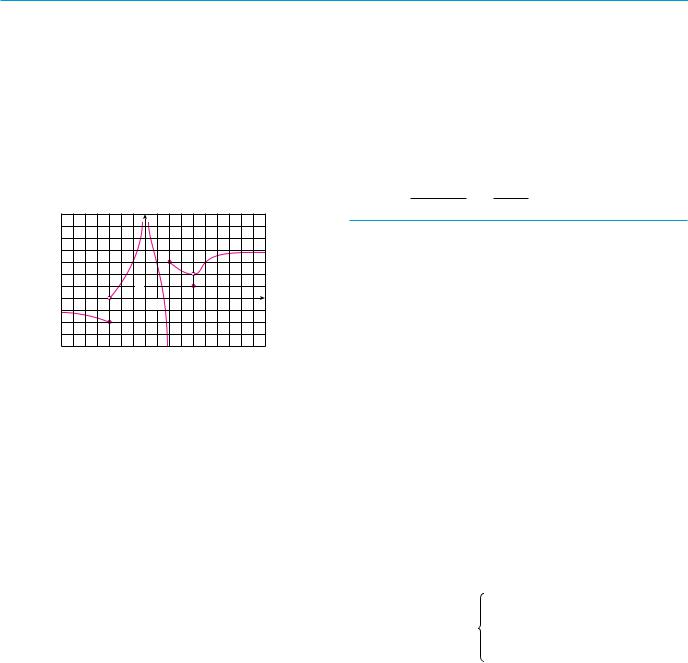
CHAPTER 2 REVIEW |||| 167
E X E R C I S E S
1.The graph of f is given.
(a) Find each limit, or explain why it does not exist.
(i) |
lim f !x" |
(ii) |
lim |
f !x" |
|
x l2# |
|
x l$3# |
|
(iii) |
lim f !x" |
(iv) |
lim f !x" |
|
|
x l$3 |
|
x l4 |
|
(v) |
lim f !x" |
(vi) |
lim |
f !x" |
|
x l0 |
|
x l2$ |
|
(vii) |
lim f !x" |
(viii) |
lim |
f !x" |
|
x l* |
|
x l$* |
|
(b)State the equations of the horizontal asymptotes.
(c)State the equations of the vertical asymptotes.
(d)At what numbers is f discontinuous? Explain.
y |
|
|
1 |
|
|
0 |
1 |
x |
2.Sketch the graph of an example of a function f that satisfies all of the following conditions:
|
lim |
|
f !x" ! $2, |
lim f !x" ! 0, |
lim f !x" ! *, |
|||||||||||||||||||||||||||
|
x l$* |
|
|
|
|
|
|
|
|
|
x l* |
|
x l$3 |
|
|
|
|
|
|
|
|
|
|
|
|
|||||||
|
lim |
|
f !x" ! $*, |
|
|
lim f !x" ! 2, |
|
|
|
|
|
|
|
|
|
|
|
|
|
|
||||||||||||
|
x l3$ |
|
|
|
|
|
|
|
|
|
|
|
x l3# |
|
|
|
|
|
|
|
|
|
|
|
|
|
|
|
||||
|
f is continuous from the right at 3 |
|
|
|
|
|
|
|
|
|
|
|
|
|
|
|||||||||||||||||
3–20 Find the limit. |
|
|
|
|
|
|
|
|
|
|
|
|
|
|
|
|
|
|
||||||||||||||
|
|
|
|
|
|
3 |
|
|
|
|
|
|
|
|
|
|
|
|
|
|
|
|
|
x2 $ 9 |
||||||||
3. |
lim ex |
$x |
|
|
|
4. |
lim |
|
|
|
|
|
|
|
|
|
|
|
|
|
||||||||||||
|
|
|
|
x2 # 2x $ 3 |
||||||||||||||||||||||||||||
|
x l1 |
|
|
|
|
|
|
|
|
|
|
|
|
|
|
x l3 |
||||||||||||||||
5. |
lim |
|
|
|
x2 $ 9 |
|
|
|
6. |
lim |
|
|
|
|
x2 $ 9 |
|
||||||||||||||||
|
|
|
|
|
|
|
|
|
|
|
|
|
|
x2 # 2x $ 3 |
||||||||||||||||||
|
x l$3 x2 # 2x $ 3 |
|
|
|
|
x l1# |
||||||||||||||||||||||||||
7. |
lim |
|
|
!h $ 1"3 # 1 |
|
|
|
|
8. |
lim |
|
t2 |
$ 4 |
|
|
|
|
|
|
|
||||||||||||
|
|
|
|
|
|
h |
|
|
|
|
t3 |
$ 8 |
|
|
|
|
|
|
|
|||||||||||||
|
h l0 |
|
|
|
|
|
|
|
|
|
t l2 |
|
|
|
|
|
|
|
||||||||||||||
|
|
|
|
|
|
|
s |
|
|
|
|
|
|
|
|
|
|
|
|
|
|
|
|
|
|
|
|
|
||||
9. |
lim |
|
|
|
|
|
r |
|
|
|
|
|
|
10. |
lim |
|
|
|
4 |
$ v |
||||||||||||
|
|
|
|
|
|
|
|
|
|
|
|
|
|
|
|
|
|
|
|
|
|
|
|
|
||||||||
|
r l9 |
!r $ 9"4 |
|
|
|
|
v l4# |
( 4 |
$ v ( |
|||||||||||||||||||||||
|
|
|
|
|
|
|
|
u 4 $ 1 |
|
|
|
|
|
|
s |
|
|
|
|
|
||||||||||||
11. |
lim |
|
|
|
|
|
|
|
12. |
lim |
x # 6 |
$ x |
|
|||||||||||||||||||
|
u3 # 5u2 $ 6u |
|
|
x3 $ 3x2 |
||||||||||||||||||||||||||||
|
u l1 |
|
x l3 |
|
|
|
||||||||||||||||||||||||||
|
|
|
|
|
|
|
|
|
|
|
|
|
|
|
|
|
|
|
|
|
|
|
|
|
|
|
|
|
|
|
||
13. |
lim |
s |
x2 $ 9 |
|
|
|
|
|
|
14. |
lim |
|
|
s |
x2 $ 9 |
|
|
|
|
|||||||||||||
|
2x $ 6 |
|
|
|
|
|
|
2x $ 6 |
||||||||||||||||||||||||
|
x l* |
|
|
|
|
|
x l$* |
|
|
|||||||||||||||||||||||
15. |
lim ln!sin x" |
|
|
|
16. |
lim |
|
1 |
$ 2x2 $ x4 |
|||||||||||||||||||||||
|
|
|
|
|
|
5 # x $ 3x4 |
||||||||||||||||||||||||||
|
x l-$ |
|
|
|
|
|
|
|
|
|
|
|
|
|
x l$* |
|
|
|||||||||||||||
17. |
lim ( |
s |
|
|
|
|
|
|
|
|
$ x) |
18. |
lim ex$x2 |
|||||||||||||||||||
x2 # 4x # 1 |
||||||||||||||||||||||||||||||||
|
x l* |
|
|
|
|
|
|
|
|
|
|
|
|
x l* |
|
|
|
|
|
|
|
|
|
|
|
|
||||||
19.lim tan$1!1'x"
xl0#
20. lim |
|
1 |
# |
|
1 |
|
|
%x $ 1 |
x2 |
$ 3x # 2 |
& |
||||
x l1 |
|
||||||
;21–22 Use graphs to discover the asymptotes of the curve. Then prove what you have discovered.
cos2x
21. y ! x2
22. y ! sx2 # x # 1 $ sx2 $ x
23. If 2x $ 1 ( f !x" ( x2 for 0 ) x ) 3, find limx l1 f !x". 24. Prove that limx l0 x2 cos!1'x2 " ! 0.
25–28 Prove the statement using the precise definition of a limit.
25. |
lim !14 |
$ 5x" ! 4 |
26. |
lim |
3 |
|
x |
! 0 |
|
|||
|
x l2 |
|
|
x l0 |
s |
|
|
|
|
|
||
27. |
lim !x2 |
$ 3x" ! $2 |
28. |
lim |
|
|
|
2 |
|
! * |
||
|
|
|
|
|
|
|
||||||
|
x l2 |
|
|
x l4# |
sx $ 4 |
|
||||||
29. |
Let |
|
|
|
|
|
|
|
|
|
|
|
|
s |
|
|
if x ) 0 |
|
$x |
|||
f !x" ! |
3 $ x |
if 0 ( x ) 3 |
||
|
+!x $ 3"2 |
if x + 3 |
||
(a) Evaluate each limit, if it exists.
(i) |
lim |
f !x" |
(ii) |
lim |
f !x" |
(iii) |
lim f !x" |
|
x l0# |
|
|
x l0$ |
|
|
x l0 |
(iv) |
lim |
f !x" |
(v) |
lim |
f !x" |
(vi) |
lim f !x" |
|
x l3$ |
|
|
x l3# |
|
|
x l3 |
(b)Where is f discontinuous?
(c)Sketch the graph of f.
30.Let
2x $ x2 if 0 ( x ( 2
t2 $ x if 2 ) x ( 3
!x" !
x $ 4 if 3 ) x ) 4 - if x ' 4
(a)For each of the numbers 2, 3, and 4, discover whether t is continuous from the left, continuous from the right, or continuous at the number.
(b)Sketch the graph of t.
31–32 Show that each function is continuous on its domain. State the domain.
31. h!x" ! xesin x |
32. t!x" ! |
s |
x2 |
$ 9 |
|
|
||
x |
2 |
$ 2 |
|
|
||||
|
|
|
|
|
||||
|
|
|
|
|
|
|
|
|
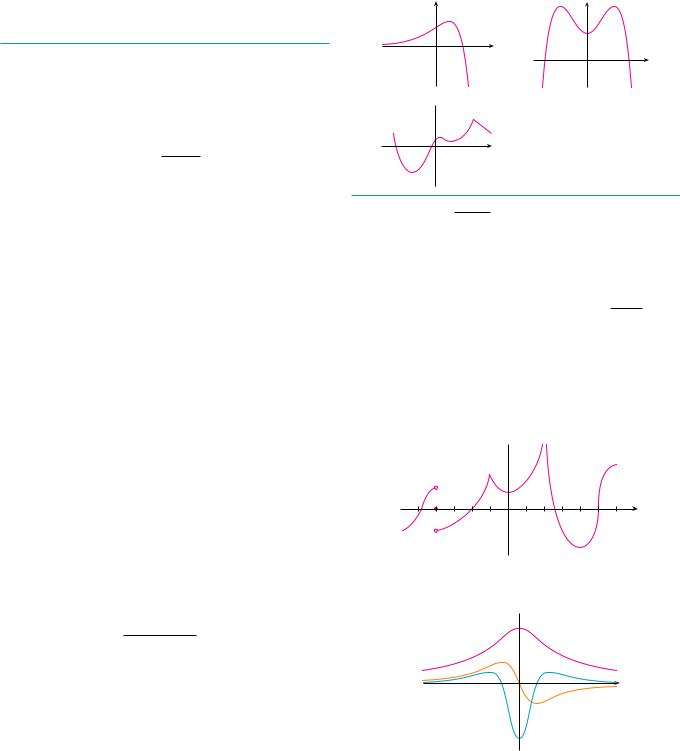
168 |||| CHAPTER 2 LIMITS AND DERIVATIVES
33–34 Use the Intermediate Value Theorem to show that there is a root of the equation in the given interval.
33. 2x3 # x2 # 2 ! 0, !$2, $1"
34.e$x2 ! x, !0, 1"
35.(a) Find the slope of the tangent line to the curve y ! 9 $ 2x2 at the point !2, 1".
(b) Find an equation of this tangent line.
36.Find equations of the tangent lines to the curve
2
y ! 1 $ 3x
at the points with x-coordinates 0 and $1.
37.The displacement (in meters) of an object moving in a straight line is given by s ! 1 # 2t # 14 t2, where t is measured in seconds.
(a) Find the average velocity over each time period.
(i) |
#1, |
3$ |
(ii) |
#1, |
2$ |
(iii) |
#1, |
1.5$ |
(iv) |
#1, |
1.1$ |
(b)Find the instantaneous velocity when t ! 1.
38.According to Boyle’s Law, if the temperature of a confined gas is held fixed, then the product of the pressure P and the volume V is a constant. Suppose that, for a certain gas,
PV ! 800, where P is measured in pounds per square inch and V is measured in cubic inches.
(a)Find the average rate of change of P as V increases from 200 in3 to 250 in3.
(b)Express V as a function of P and show that the instantaneous rate of change of V with respect to P is inversely proportional to the square of P.
39.(a) Use the definition of a derivative to find f !!2", where
f !x" ! x3 $ 2x.
(b) Find an equation of the tangent line to the curve y ! x3 $ 2x at the point (2, 4).
;(c) Illustrate part (b) by graphing the curve and the tangent line on the same screen.
40.Find a function f and a number a such that
lim !2 # h"6 $ 64 ! f !!a"
h l0 h
41.The total cost of repaying a student loan at an interest rate of r% per year is C ! f !r".
(a)What is the meaning of the derivative f !!r"? What are its units?
(b)What does the statement f !!10" ! 1200 mean?
(c)Is f !!r" always positive or does it change sign?
42– 44 Trace or copy the graph of the function. Then sketch a graph of its derivative directly beneath.
42. |
y |
43. |
y |
0 x
0 x
44.y
x
45.(a) If f !x" ! s3 $ 5x , use the definition of a derivative to find f !!x".
(b) Find the domains of f and f !.
;(c) Graph f and f ! on a common screen. Compare the graphs to see whether your answer to part (a) is reasonable.
46.(a) Find the asymptotes of the graph of f !x" ! 43 $# xx and
use them to sketch the graph.
(b)Use your graph from part (a) to sketch the graph of f !.
(c)Use the definition of a derivative to find f !!x".
;(d) Use a graphing device to graph f ! and compare with your sketch in part (b).
47.The graph of f is shown. State, with reasons, the numbers at which f is not differentiable.
y
_1 |
0 |
2 |
4 |
6 |
x |
;48. The figure shows the graphs of f , f !, and f ". Identify each curve, and explain your choices.
y
a
b
0 |
x |
c
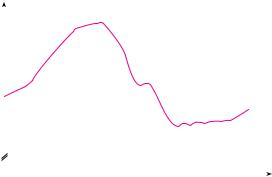
49. Let C!t" be the total value of US currency (coins and banknotes) in circulation at time t. The table gives values of this function from 1980 to 2000, as of September 30, in billions of dollars. Interpret and estimate the value of C!!1990".
t |
1980 |
1985 |
1990 |
1995 |
2000 |
|
|
|
|
|
|
C!t" |
129.9 |
187.3 |
271.9 |
409.3 |
568.6 |
|
|
|
|
|
|
50. The total fertility rate at time t, denoted by F!t", is an estimate of the average number of children born to each woman (assuming that current birth rates remain constant). The graph of the total fertility rate in the United States shows the fluctuations from 1940 to 1990.
(a) Estimate the values of F!!1950", F!!1965", and F!!1987".
(b) What are the meanings of these derivatives?
(c) Can you suggest reasons for the values of these derivatives?
|
|
|
|
|
|
|
|
|
|
|
CHAPTER 2 |
REVIEW |
|||| 169 |
|||||||||||||
y |
|
|
|
baby |
|
|
|
|
|
|
|
|
|
|
|
|
|
|
|
|
|
|
|
|||
3.5 |
|
|
|
|
|
|
|
|
|
|
|
|
|
|
|
|
|
|
|
|
|
|
|
|||
|
|
|
|
boom |
|
|
|
|
|
|
|
|
|
|
|
|
|
|
|
|
|
|
|
|||
|
|
|
|
|
|
|
|
|
|
|
|
|
|
|
|
|
|
|
|
|
|
|
||||
3.0 |
|
|
|
|
|
|
|
|
|
|
|
|
baby |
|
|
|
|
|
|
|
|
|
||||
|
|
|
|
|
|
|
|
|
|
|
|
|
|
|
|
|
|
|
|
|
||||||
2.5 |
|
|
|
|
|
|
|
|
|
|
|
|
bust |
|
|
|
|
|
|
|
|
|
||||
|
|
|
|
y=F(t) |
|
|
|
|
|
|
|
|
|
|
|
|
baby |
|
|
|
|
|||||
|
|
|
|
|
|
|
|
|
|
|
|
|
|
|
|
|
|
|
|
|||||||
2.0 |
|
|
|
|
|
|
|
|
|
|
|
|
|
|
|
|
|
|
|
boomlet |
|
|||||
|
|
|
|
|
|
|
|
|
|
|
|
|
|
|
|
|
|
|
|
|
|
|
|
|
|
|
|
|
|
|
|
|
|
|
|
|
|
|
|
|
|
|
|
|
|
|
|
|
|
|
|
|
|
1.5 |
|
|
|
|
|
|
|
|
|
|
|
|
|
|
|
|
|
|
|
|
|
|
|
|
|
|
|
|
|
|
|
|
|
|
|
|
|
|
|
|
|
|
|
|
|
|
|
|
|
|
|
|
|
|
|
|
|
|
|
|
|
|
|
|
|
|
|
|
|
|
|
|
|
|
|
|
|
|
|
|
|
|
|
|
|
|
|
|
|
|
|
|
|
|
|
|
|
|
|
|
|
|
|
|
|
|
|
|
|
|
|
|
|
|
|
|
|
|
|
|
|
|
|
|
|
|
|
|
|
|
|
|
|
|
1940 |
1950 |
1960 |
1970 |
|
|
1980 |
|
|
1990 |
t |
||||||||||||||||
|
|
|
|
|
||||||||||||||||||||||
51.Suppose that ( f !x" ( ( t!x" for all x, where limx la t!x" ! 0. Find limx la f !x".
52.Let f !x" ! ) x* # )$x*.
(a)For what values of a does limx la f !x" exist?
(b)At what numbers is f discontinuous?
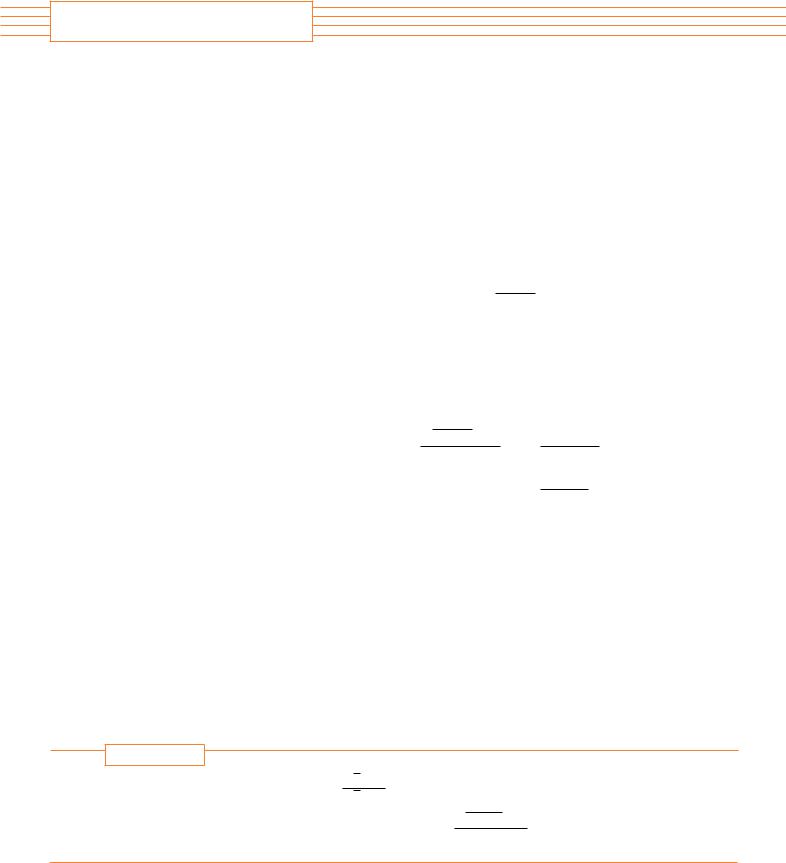
P R O B L E M S P L U S
In our discussion of the principles of problem solving we considered the problem-solving strategy of introducing something extra (see page 76). In the following example we show how this principle is sometimes useful when we evaluate limits. The idea is to change the variable—to introduce a new variable that is related to the original variable—in such a way as to make the problem simpler. Later, in Section 5.5, we will make more extensive use of this general idea.
|
3 |
|
|
|
EXAMPLE 1 Evaluate lim |
s1 ! cx " 1 |
, where c is a nonzero constant. |
||
|
||||
x l0 |
|
x |
|
|
SOLUTION As it stands, this limit looks challenging. In Section 2.3 we evaluated several limits in which both numerator and denominator approached 0. There our strategy was to perform some sort of algebraic manipulation that led to a simplifying cancellation, but here it’s not clear what kind of algebra is necessary.
So we introduce a new variable t by the equation
t ! s3 1 ! cx
We also need to express x in terms of t, so we solve this equation:
t3 ! 1 ! cx |
x ! |
t3 |
" 1 |
|
c |
||
|
|
|
Notice that x l 0 is equivalent to t l 1. This allows us to convert the given limit into one involving the variable t:
lim s3 1 ! cx " 1
x l0 x
! lim
t " 1
t l1 !t3 " 1"#c
c!t " 1"
! lim t3 " 1
t l1
The change of variable allowed us to replace a relatively complicated limit by a simpler one of a type that we have seen before. Factoring the denominator as a difference of cubes, we get
lim |
c!t " 1" |
! lim |
|
|
|
c!t " 1" |
|
|||
t3 " 1 |
|
!t " 1"!t2 ! t ! 1" |
|
|||||||
t l1 |
t l1 |
|
||||||||
|
|
! lim |
|
|
c |
! |
c |
|
M |
|
|
|
t |
2 |
! t ! 1 |
|
|||||
|
|
t l1 |
|
3 |
|
|
||||
The following problems are meant to test and challenge your problem-solving skills. Some of them require a considerable amount of time to think through, so don’t be discouraged if you can’t solve them right away. If you get stuck, you might find it helpful to refer to the discussion of the principles of problem solving on page 76.
P R O B L E M S
1. Evaluate lim s3 x " 1 .
x l1 sx " 1
2. Find numbers a and b such that lim sax ! b " 2 ! 1.
x l0 x
170
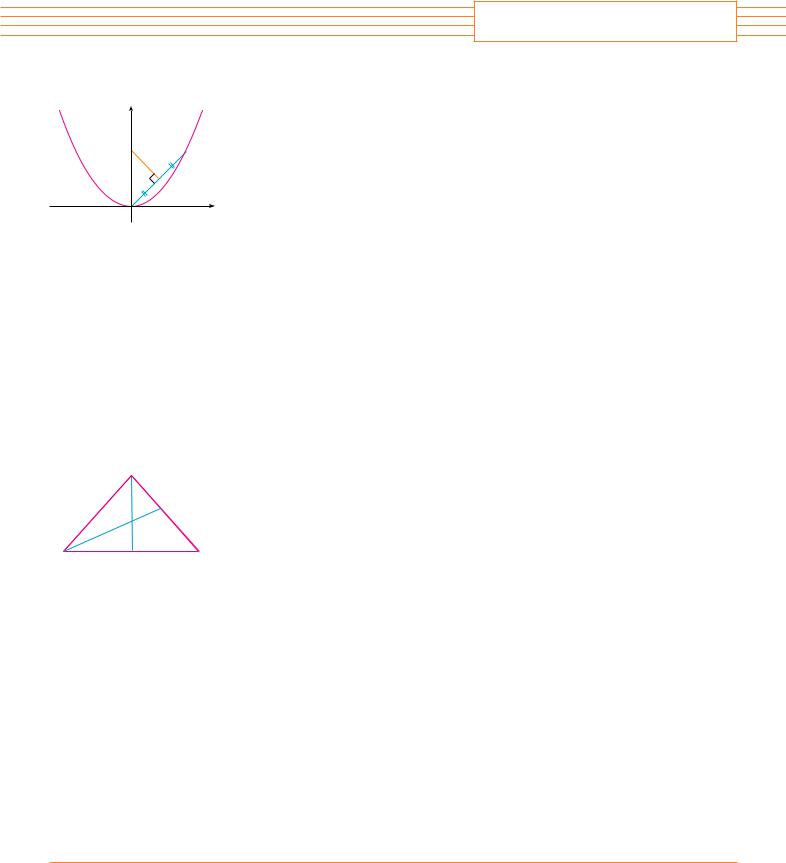
y |
y=≈ |
|
|
Q |
P |
0 |
x |
FIGURE FOR PROBLEM 4
A
P
B  C
C
M
FIGURE FOR PROBLEM 10
P R O B L E M S P L U S
3. Evaluate lim |
$ 2x " 1 |
$ " $ 2x ! 1 |
$ |
. |
|
x |
|
||
x l0 |
|
|
|
4.The figure shows a point P on the parabola y ! x2 and the point Q where the perpendicular bisector of OP intersects the y-axis. As P approaches the origin along the parabola, what happens to Q? Does it have a limiting position? If so, find it.
5. If ( x) denotes the greatest integer function, find lim |
x |
. |
|
( x) |
|||
x l' |
|
6. Sketch the region in the plane defined by each of the following equations.
(a) ( x) 2 ! ( y) 2 ! 1 (b) ( x) 2 " ( y) 2 ! 3 |
(c) ( x ! y) 2 ! 1 (d) ( x) ! ( y) ! 1 |
7. Find all values of a such that f is continuous on !: |
|
x ! 1 |
if x $ a |
f !x" ! 'x2 |
if x & a |
8.A fixed point of a function f is a number c in its domain such that f !c" ! c. (The function doesn’t move c; it stays fixed.)
(a)Sketch the graph of a continuous function with domain %0, 1& whose range also lies in %0, 1&. Locate a fixed point of f.
(b)Try to draw the graph of a continuous function with domain %0, 1& and range in %0, 1& that does not have a fixed point. What is the obstacle?
(c)Use the Intermediate Value Theorem to prove that any continuous function with domain %0, 1& and range a subset of %0, 1& must have a fixed point.
9.If limx la % f !x" ! t!x"& ! 2 and limx la % f !x" " t!x"& ! 1, find limx la % f !x"t!x"&.
10.(a) The figure shows an isosceles triangle ABC with "B ! "C. The bisector of angle B
intersects the side AC at the point P. Suppose that the base BC remains fixed but the altitude $ AM $ of the triangle approaches 0, so A approaches the midpoint M of BC. What happens to P during this process? Does it have a limiting position? If so, find it.
(b)Try to sketch the path traced out by P during this process. Then find an equation of this curve and use this equation to sketch the curve.
11.(a) If we start from 0% latitude and proceed in a westerly direction, we can let T!x" denote the temperature at the point x at any given time. Assuming that T is a continuous function of x, show that at any fixed time there are at least two diametrically opposite points on the equator that have exactly the same temperature.
(b)Does the result in part (a) hold for points lying on any circle on the earth’s surface?
(c)Does the result in part (a) hold for barometric pressure and for altitude above sea level?
12.If f is a differentiable function and t!x" ! xf !x", use the definition of a derivative to show that t#!x" ! xf #!x" ! f !x".
13. Suppose f is a function that satisfies the equation
|
f !x ! y" ! f !x" ! f ! y" ! x2 y ! xy2 |
||
for all real numbers x and y. Suppose also that |
|
||
|
lim |
f !x" |
! 1 |
|
x |
||
|
x l0 |
|
|
(a) Find f !0". |
(b) Find f #!0". |
(c) |
Find f #!x". |
14.Suppose f is a function with the property that $ f !x" $ $ x2 for all x. Show that f !0" ! 0. Then show that f #!0" ! 0.
171
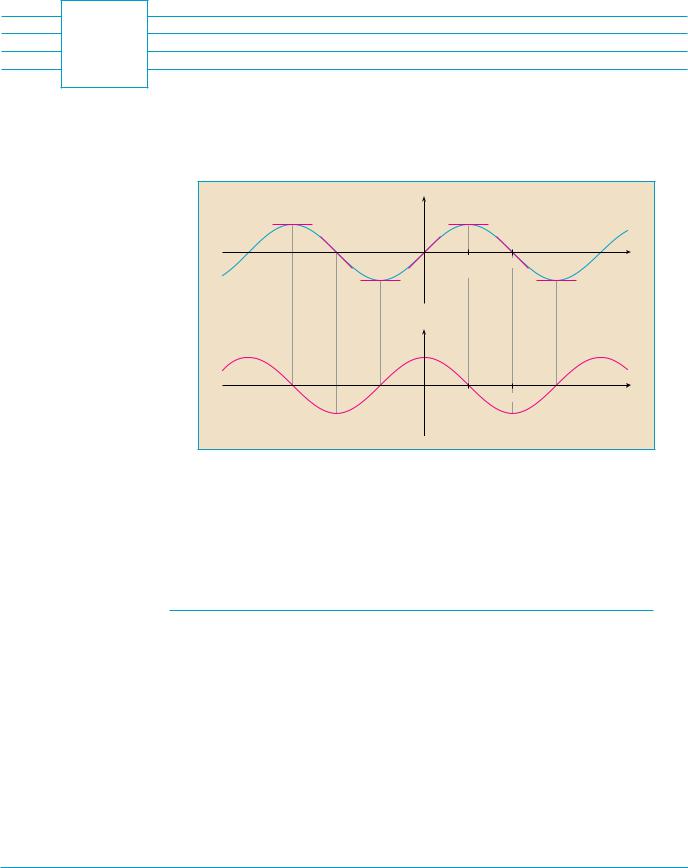
3 |
|
|
|
DIFFERENTIATION |
|
|
|
RULES |
|
|
|
y |
|
|
|
|
m=0 |
|
y=Ä=sin x |
m=1 |
|
m=_1 |
|
0 |
π |
π |
x |
|
2 |
|
|
y |
|
|
y=f»(x) |
|
|
|
|
0 |
π |
π |
x |
|
2 |
|
|
By measuring slopes at points on the sine curve, we get strong visual evidence that the derivative of the sine function is the cosine function.
We have seen how to interpret derivatives as slopes and rates of change. We have seen how to estimate derivatives of functions given by tables of values. We have learned how to graph derivatives of functions that are defined graphically. We have used the definition of a derivative to calculate the derivatives of functions defined by formulas. But it would be tedious if we always had to use the definition, so in this chapter we develop rules for finding derivatives without having to use the definition directly. These differentiation rules enable us to calculate with relative ease the derivatives of polynomials, rational functions, algebraic functions, exponential and logarithmic functions, and trigonometric and inverse trigonometric functions. We then use these rules to solve problems involving rates of change and the approximation of functions.
172
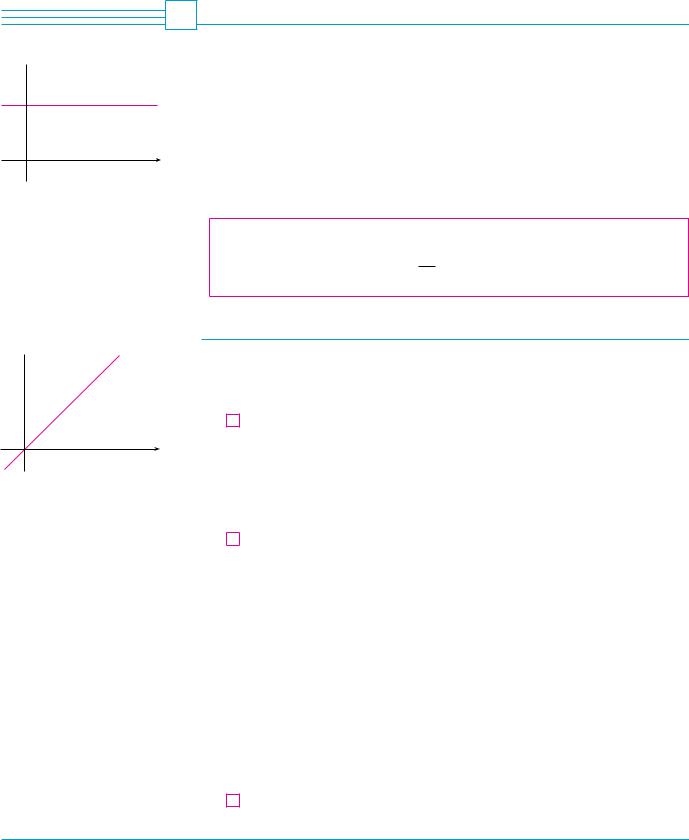
y
cy=c slope=0
0
FIGURE 1
The graph of Ä=c is the line y=c, so f»(x)=0.
y
y=x
slope=1
0
FIGURE 2
The graph of Ä=x is the line y=x, so f»(x)=1.
3.1D E R I VAT I V E S O F P O LY N O M I A L S A N D E X P O N E N T I A L F U N C T I O N S
In this section we learn how to differentiate constant functions, power functions, polynomials, and exponential functions.
Let’s start with the simplest of all functions, the constant function f ! x" ! c. The graph of this function is the horizontal line y ! c, which has slope 0, so we must have f #!x" ! 0. (See Figure 1.) A formal proof, from the definition of a derivative, is also easy:
f #! x" ! lim |
f ! x ! h" " f ! x" |
! lim |
c " c |
! lim 0 ! 0 |
|
h |
h |
||||
h l0 |
h l0 |
h l0 |
|||
x |
|
|
|
|
In Leibniz notation, we write this rule as follows.
DERIVATIVE OF A CONSTANT FUNCTION
dxd !c" ! 0
P OW E R F U N C T I O N S
We next look at the functions f ! x" ! xn, where n is a positive integer. If n ! 1, the graph of f !x" ! x is the line y ! x, which has slope 1. (See Figure 2.) So
1 |
|
d |
! x" ! 1 |
|
dx |
||
|
|
|
|
|
|
|
|
x
(You can also verify Equation 1 from the definition of a derivative.) We have already investigated the cases n ! 2 and n ! 3. In fact, in Section 2.8 (Exercises 17 and 18) we found that
2 |
|
d |
! x2 |
" ! 2x |
|
d |
! x3 " ! 3x2 |
|
|
||||||
|
|
dx |
|
|
|||||||||||
|
|
dx |
|
|
|
|
|
|
|
|
|
||||
For n ! 4 we find the derivative of f ! x" ! x4 as follows: |
|
|
|||||||||||||
|
f #! x" ! lim |
|
|
f !x ! h" " f ! x" |
! lim |
!x ! h"4 |
" x4 |
||||||||
|
|
|
|
h |
|
|
|
|
|
h |
|
||||
|
|
h l0 |
|
|
|
|
|
h l0 |
|
|
|
||||
|
! lim |
|
x4 ! 4x3h ! 6x2h2 ! 4xh3 ! h4 " x4 |
||||||||||||
|
|
|
|
|
|
|
h |
|
|
|
|
||||
|
|
h l0 |
|
|
|
|
|
|
|
|
|
|
|||
|
! lim |
4x3h ! 6x2h2 ! 4xh3 ! h4 |
|
|
|||||||||||
|
|
|
|
h |
|
|
|
|
|
||||||
|
|
h l0 |
|
|
|
|
|
|
|
|
|||||
|
! lim !4x3 ! 6x2h ! 4xh2 ! h3 " ! 4x3 |
|
|||||||||||||
|
|
h l0 |
|
|
|
|
|
|
|
|
|
|
|
||
Thus |
|
|
|
|
|
|
|
|
|
|
|
|
|
|
|
3 |
|
|
|
|
|
|
d |
! x4 " ! 4x3 |
|
|
|
|
|||
|
|
|
|
|
|
dx |
|
|
|
|
|||||
|
|
|
|
|
|
|
|
|
|
|
|
|
|
|
|
173

174 |||| CHAPTER 3 DIFFERENTIATION RULES
Comparing the equations in (1), (2), and (3), we see a pattern emerging. It seems to be a reasonable guess that, when n is a positive integer, !d%dx"! xn " ! nxn"1. This turns out to be true.
N The Binomial Theorem is given on Reference Page 1.
THE POWER RULE If n is a positive integer, then
dxd ! xn " ! nxn"1
FIRST PROOF The formula
xn " an ! ! x " a"! xn"1 ! xn"2a ! $ $ $ ! xan"2 ! an"1 "
can be verified simply by multiplying out the right-hand side (or by summing the second factor as a geometric series). If f !x" ! xn, we can use Equation 2.7.5 for f #!a" and the equation above to write
f #!a" ! lim |
f ! x" " f !a" |
! lim |
xn " an |
|
x " a |
x " a |
|||
x la |
x la |
!lim ! xn"1 ! xn"2a ! $ $ $ ! xan"2 ! an"1 "
x la
!an"1 ! an"2a ! $ $ $ ! aan"2 ! an"1
!nan"1
SECOND PROOF
|
f #! x" ! lim |
f !x ! h" " f ! x" |
! lim |
!x ! h"n " xn |
|
|
|
||||||||||||
|
|
|
|
h |
|
h |
|
|
|
|
|
||||||||
|
|
|
|
h l0 |
|
|
|
|
h l0 |
|
|
|
|
|
|||||
In finding the derivative of x4 we had to expand ! x ! h"4. Here we need to expand |
|
||||||||||||||||||
! x ! h"n and we use the Binomial Theorem to do so: |
|
|
|
|
|
|
|
||||||||||||
|
# |
xn ! nxn"1h ! |
n!n " 1" |
xn"2h2 ! $ $ $ ! nxhn"1 ! hn |
$ |
" xn |
|
||||||||||||
f #! x" ! lim |
|
|
|||||||||||||||||
|
|
|
|
|
|
|
2 |
|
|
|
|
|
|
|
|
||||
|
|
|
|
|
|
|
|
|
|
|
h |
|
|
|
|
|
|
|
|
h l0 |
|
|
|
|
|
|
|
|
|
|
|
|
|
|
|
|
|
|
|
|
nxn"1h ! |
n!n " 1" |
|
xn"2h2 ! $ $ $ ! nxhn"1 ! hn |
|
|
|
|
|
||||||||||
! lim |
|
|
|
|
|
|
|
||||||||||||
|
|
|
|
|
|
2 |
|
|
|
|
|
|
|
|
|
|
|
|
|
|
|
|
|
|
|
|
|
|
h |
|
|
|
|
|
|
|
|
|
|
h l0 |
# |
|
|
|
|
|
|
|
|
|
|
|
|
$ |
|
|
|
||
! lim |
nxn"1 |
! |
|
n!n " 1" |
xn"2h ! $ $ $ ! nxhn"2 ! hn"1 |
|
|
|
|||||||||||
|
|
|
|
|
|
||||||||||||||
h l0 |
|
|
|
|
|
2 |
|
|
|
|
|
|
|
|
|
|
|||
! nxn"1 |
|
|
|
|
|
|
|
|
|
|
|
|
|
|
|
|
|
|
|
because every term except the first has h as a factor and therefore approaches 0. |
M |
||||||||||||||||||
We illustrate the Power Rule using various notations in Example 1.
EXAMPLE 1 |
|
|
|
|
|
|
||
(a) |
If f !x" ! x6, then f #! x" ! 6x5. |
(b) |
If y ! x1000, then y# ! 1000x999. |
|
||||
(c) |
If y ! t4, then |
dy |
! 4t3. |
(d) |
d |
!r3 " ! 3r2 |
M |
|
dt |
dr |
|||||||
|
|
|
|
|
|
|||

N Figure 3 shows the function y in Example 2(b) and its derivative y#. Notice that y is not differentiable at 0 (y# is not defined there). Observe that y# is positive when y increases and is negative when y decreases.
|
2 |
y |
y» |
|
|
_3 |
3 |
|
_2 |
FIGURE 3 |
|
y=Ïã#≈ |
|
SECTION 3.1 DERIVATIVES OF POLYNOMIALS AND EXPONENTIAL FUNCTIONS |||| 175
What about power functions with negative integer exponents? In Exercise 61 we ask you to verify from the definition of a derivative that
dxd &1x ' ! " x12
We can rewrite this equation as
dxd ! x"1 " ! !"1"x"2
and so the Power Rule is true when n ! "1. In fact, we will show in the next section [Exercise 58(c)] that it holds for all negative integers.
What if the exponent is a fraction? In Example 3 in Section 2.8 we found that
d |
|
|
|
1 |
|
|
|
sx ! |
|||||||
dx |
2s |
|
|
||||
x |
|||||||
which can be written as
dxd ! x1%2 " ! 12 x"1%2
This shows that the Power Rule is true even when n ! 12 . In fact, we will show in Section 3.6 that it is true for all real numbers n.
THE POWER RULE (GENERAL VERSION) If n is any real number, then
|
|
|
|
|
|
|
|
|
|
|
|
|
|
|
|
d |
! xn " ! nxn"1 |
|
|
|
|
|
|
|
|
||||
|
|
|
|
|
|
|
|
|
|
|
|
|
|
|
|
|
|
|
|
|
|
|
|
|
|||||
|
|
|
|
|
|
|
|
|
|
|
|
|
|
|
|
dx |
|
|
|
|
|
|
|
|
|
|
|
||
|
|
|
|
|
|
|
|
|
|
|
|
|
|
|
|
|
|
|
|
|
|
|
|
||||||
EXAMPLE 2 Differentiate: |
|
|
|
|
|
|
|
|
|
|
|
|
|
|
|
|
|
|
|
|
|
|
|
||||||
|
|
1 |
|
|
|
|
|
|
|
|
|
|
|
|
|
|
|
|
|
|
|
|
|
|
|
|
|
|
|
(a) |
f ! x" ! |
|
|
|
|
|
|
|
|
|
|
|
|
|
|
(b) y ! sx2 |
|
|
|
|
|
||||||||
|
2 |
|
|
|
|
|
|
|
|
|
|
|
|
|
|
|
|
|
|
|
|
||||||||
|
|
|
|
|
|
|
|
|
|
|
|
|
|
|
|
|
|
|
|
|
3 |
|
|
|
|
|
|
|
|
|
|
x |
|
|
|
|
|
|
|
|
|
|
|
|
|
|
|
|
|
|
|
|
|
|
|
|
|
|
|
SOLUTION In each case we rewrite the function as a power of x. |
|
|
|
|
|
||||||||||||||||||||||||
(a) |
Since f !x" ! x"2, we use the Power Rule with n ! "2: |
|
|
|
|
|
|||||||||||||||||||||||
|
|
|
|
|
f #! x" ! |
|
d |
|
! x"2 |
" ! "2x"2"1 ! "2x"3 ! " |
2 |
|
|
||||||||||||||||
|
|
|
|
|
dx |
x3 |
|
||||||||||||||||||||||
|
|
|
|
|
|
|
|
|
|
|
|
|
|
|
|
|
|
|
|
|
|
|
|
|
|||||
|
|
|
|
|
dy |
d |
|
3 |
|
|
|
) |
|
|
|
d |
|
2%3 |
2 |
|
!2%3""1 |
2 |
|
"1%3 |
|
||||
|
|
|
|
|
|
|
|
2 |
|
|
|
|
|
||||||||||||||||
|
|
|
|
|
|
|
|
|
|
|
|
|
|
|
|
|
|
|
|||||||||||
(b) |
|
|
|
|
dx ! dx (sx |
|
|
! dx !x |
|
" ! 3 |
x |
|
|
! 3 |
x |
|
|
M |
|||||||||||
The Power Rule enables us to find tangent lines without having to resort to the definition of a derivative. It also enables us to find normal lines. The normal line to a curve C at a point P is the line through P that is perpendicular to the tangent line at P. (In the study of optics, one needs to consider the angle between a light ray and the normal line to a lens.)
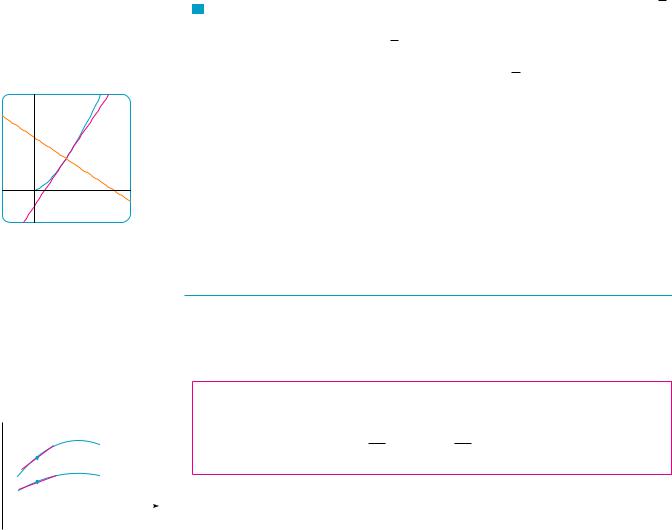
176 |||| CHAPTER 3 DIFFERENTIATION RULES
3 |
|
|
tangent |
|
normal |
_1 |
3 |
_1 |
|
FIGURE 4 |
|
N GEOMETRIC INTERPRETATION OF
THE CONSTANT MULTIPLE RULE
y
y=2Ä
y=Ä
0 |
x |
Multiplying by c ! 2 stretches the graph vertically by a factor of 2. All the rises have been doubled but the runs stay the same. So the slopes are doubled, too.
V EXAMPLE 3 Find equations of the tangent line and normal line to the curve y ! xsx at the point !1, 1". Illustrate by graphing the curve and these lines.
SOLUTION The derivative of f ! x" ! xsx ! xx1%2 ! x3%2 is
f #! x" ! 32 x!3%2""1 ! 32 x1%2 ! 32 sx
So the slope of the tangent line at (1, 1) is f #!1" ! 32 . Therefore an equation of the tangent line is
y " 1 ! 32 ! x " 1" or y ! 32 x " 12
The normal line is perpendicular to the tangent line, so its slope is the negative reciprocal of 32, that is, "23. Thus an equation of the normal line is
y " 1 ! "23 ! x " 1" or y ! "23 x ! 53
We graph the curve and its tangent line and normal line in Figure 4. |
M |
N E W D E R I VAT I V E S F RO M O L D
When new functions are formed from old functions by addition, subtraction, or multiplication by a constant, their derivatives can be calculated in terms of derivatives of the old functions. In particular, the following formula says that the derivative of a constant times a function is the constant times the derivative of the function.
THE CONSTANT MULTIPLE RULE If c is a constant and f is a differentiable function, then
dxd (cf !x") ! c dxd f ! x"
PROOF Let t! x" ! cf !x". Then |
|
|
|
|
||||
t#!x" ! lim |
t! x ! h" " t! x" |
! lim |
||||||
|
||||||||
h l0 |
# |
h |
|
|
h l0 |
|||
h l0 |
h |
|
|
$ |
||||
! lim c |
|
|
|
f ! x ! h" " f ! x" |
|
|||
|
f ! x ! h" " f ! x" |
|
||||||
! c lim |
|
|
||||||
|
|
|
h |
|
|
|
||
h l0 |
|
|
|
|
|
|
||
! cf #! x"
cf ! x ! h" " cf !x" h
(by Law 3 of limits)
M
EXAMPLE 4 |
|
|
|
|
|
|
|
|
|||
(a) |
|
d |
!3x |
4 " ! 3 |
|
d |
! x4 " ! 3!4x3 " ! 12x3 |
|
|||
|
dx |
dx |
|
||||||||
|
|
|
|
|
|
|
|
|
|||
(b) |
d |
!"x" ! |
d |
|
(!"1" x) ! !"1" |
d |
!x" ! "1!1" ! "1 |
M |
|||
|
|
|
|||||||||
dx |
dx |
dx |
|||||||||
The next rule tells us that the derivative of a sum of functions is the sum of the derivatives.

N Using prime notation, we can write the Sum Rule as
! f ! t"# ! f # ! t#
SECTION 3.1 DERIVATIVES OF POLYNOMIALS AND EXPONENTIAL FUNCTIONS |||| 177
THE SUM RULE If f and t are both differentiable, then
dxd ( f !x" ! t!x") ! dxd f ! x" ! dxd t! x"
PROOF Let F! x" ! f ! x" ! t! x". Then |
|
|
|
|
|
|
|
|
|||
F#!x" ! lim |
F!x ! h" " F! x" |
|
|
|
|
|
|
|
|
||
|
|
h |
|
|
|
|
|
|
|
|
|
h l0 |
|
|
|
|
|
|
|
|
|
|
|
! lim |
( f ! x ! h" ! t! x ! h") " ( f ! x" ! t! x") |
|
|
||||||||
|
|
|
|||||||||
h l0 |
|
|
|
|
|
h |
|
|
|
|
|
! lim |
|
|
f !x ! h" " f ! x" |
! |
t! x ! h" " t! x" |
|
|
|
|||
# |
h |
|
|
|
$ |
|
|||||
h l0 |
|
|
|
|
h |
|
|||||
! lim |
f !x ! h" " f ! x" |
|
! lim |
t! x ! h" " t! x" |
(by Law 1) |
||||||
|
|
h |
|
|
|
||||||
h l0 |
|
|
|
|
h l0 |
h |
|
|
|
||
! f #! x" ! t#! x" |
|
|
|
|
|
|
|
M |
|||
The Sum Rule can be extended to the sum of any number of functions. For instance, using this theorem twice, we get
! f ! t ! h"# ! (! f ! t" ! h)# ! ! f ! t"# ! h# ! f # ! t# ! h#
By writing f " t as f ! !"1"t and applying the Sum Rule and the Constant Multiple Rule, we get the following formula.
THE DIFFERENCE RULE If f and t are both differentiable, then
dxd ( f !x" " t!x") ! dxd f ! x" " dxd t! x"
The Constant Multiple Rule, the Sum Rule, and the Difference Rule can be combined with the Power Rule to differentiate any polynomial, as the following examples demonstrate.
EXAMPLE 5
dxd ! x8 ! 12x5 " 4x4 ! 10x3 " 6x ! 5"
!dxd ! x8 " ! 12 dxd ! x5 " " 4 dxd ! x4 " ! 10 dxd ! x3 " " 6 dxd ! x" ! dxd !5"
!8x7 ! 12!5x4 " " 4!4x3 " ! 10!3x2 " " 6!1" ! 0
! 8x7 ! 60x4 " 16x3 ! 30x2 " 6 |
M |
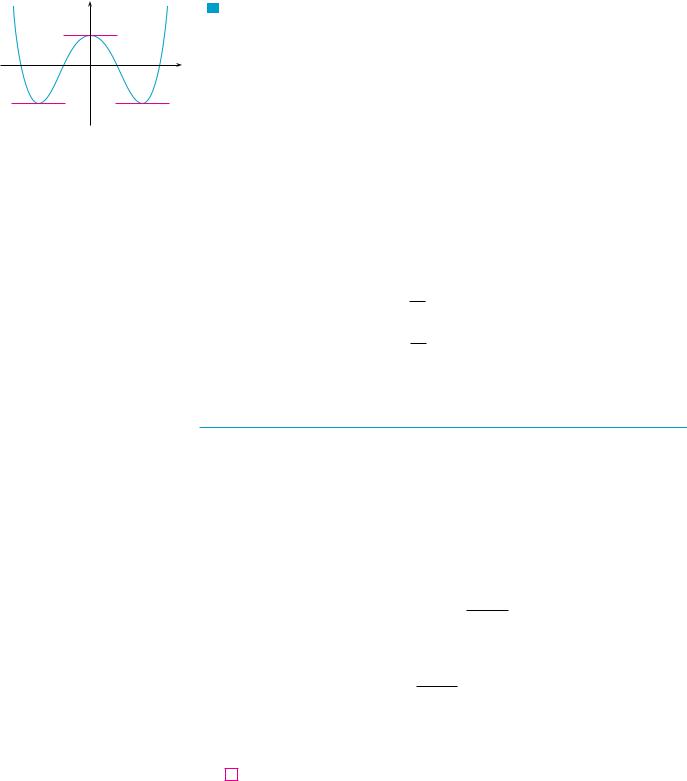
178 |||| CHAPTER 3 DIFFERENTIATION RULES
y |
|
|
(0,#4) |
0 |
x |
{_ Ïã3,#_5} |
{Ïã3,#_5} |
FIGURE 5
The curve y=x$-6x@+4 and its horizontal tangents
V EXAMPLE 6 Find the points on the curve y ! x4 " 6x2 ! 4 where the tangent line is horizontal.
SOLUTION Horizontal tangents occur where the derivative is zero. We have
dy ! |
d |
|
|
!x4 " " 6 |
d |
!x2 " ! |
d |
!4" |
|||
dx |
dx |
|
|||||||||
dx |
|
|
|
dx |
|
||||||
! 4x3 " 12x ! 0 ! 4x!x2 " 3" |
|||||||||||
Thus dy%dx ! 0 if x ! 0 or x2 " 3 ! 0, that is, x ! %s |
|
|
So the given curve has |
||||||||
3. |
|||||||||||
horizontal tangents when x ! 0, |
s |
|
|
s |
|
|
|
|
|
|
|
|
3, and " |
3. The corresponding points are !0, 4", |
|||||||||
(s3, "5), and ("s3, "5). (See Figure 5.) |
|
|
|
|
|
|
M |
||||
EXAMPLE 7 The equation of motion of a particle is s ! 2t3 " 5t2 ! 3t ! 4, where s is measured in centimeters and t in seconds. Find the acceleration as a function of time. What is the acceleration after 2 seconds?
SOLUTION The velocity and acceleration are
v!t" ! dsdt ! 6t2 " 10t ! 3 a!t" ! ddtv ! 12t " 10
The acceleration after 2 s is a!2" ! 14 cm%s2. |
M |
E X P O N E N T I A L F U N C T I O N S
Let’s try to compute the derivative of the exponential function f ! x" ! ax using the definition of a derivative:
f #!x" ! lim |
f !x ! h" " f ! x" |
! lim |
ax!h |
" ax |
||
h |
|
|
|
h |
||
h l0 |
|
|
h l0 |
|
||
! lim |
axah " ax |
! lim |
ax!ah " 1" |
|
||
h |
h |
|
|
|||
h l0 |
h l0 |
|
|
|||
The factor ax doesn’t depend on h, so we can take it in front of the limit:
f #! x" ! ax lim ah " 1
h l0 h
Notice that the limit is the value of the derivative of f at 0, that is,
lim ah " 1 ! f #!0"
h l0 h
Therefore we have shown that if the exponential function f ! x" ! ax is differentiable at 0, then it is differentiable everywhere and
4 |
f #!x" ! f #!0"ax |
This equation says that the rate of change of any exponential function is proportional to the function itself. (The slope is proportional to the height.)
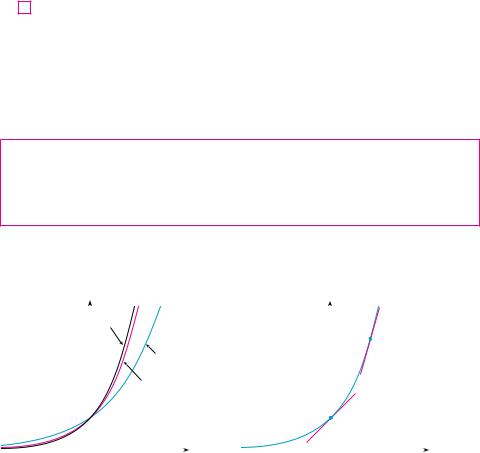
h |
|
2h " 1 |
|
|
3h " 1 |
|
|
h |
|
h |
|||
|
|
|
||||
|
|
|
|
|
|
|
0.1 |
|
0.7177 |
|
|
1.1612 |
|
0.01 |
|
0.6956 |
|
|
1.1047 |
|
0.001 |
|
0.6934 |
|
|
1.0992 |
|
0.0001 |
|
0.6932 |
|
|
1.0987 |
|
|
|
|
|
|
|
|
SECTION 3.1 DERIVATIVES OF POLYNOMIALS AND EXPONENTIAL FUNCTIONS |||| 179
Numerical evidence for the existence of f #!0" is given in the table at the left for the cases a ! 2 and a ! 3. (Values are stated correct to four decimal places.) It appears that the limits exist and
for a ! 2, |
f #!0" ! lim |
2h " 1 |
* 0.69 |
|
h |
||||
|
h l0 |
|
||
for a ! 3, |
f #!0" ! lim |
3h " 1 |
* 1.10 |
|
h |
||||
|
h l0 |
|
In fact, it can be proved that these limits exist and, correct to six decimal places, the values are
|
d |
!2x " +x!0 |
* 0.693147 |
d |
|
!3x " +x!0 |
* 1.098612 |
||
|
dx |
dx |
|
||||||
Thus, from Equation 4, we have |
|
|
|
|
|||||
5 |
|
|
d |
!2x " * !0.69"2x |
d |
|
!3x " * !1.10"3x |
||
|
dx |
||||||||
|
|
|
dx |
|
|
|
|
||
N In Exercise 1 we will see that e lies between 2.7 and 2.8. Later we will be able to show that, correct to five decimal places,
e * 2.71828
Of all possible choices for the base a in Equation 4, the simplest differentiation formula occurs when f #!0" ! 1. In view of the estimates of f #!0" for a ! 2 and a ! 3, it seems reasonable that there is a number a between 2 and 3 for which f #!0" ! 1. It is traditional to denote this value by the letter e. (In fact, that is how we introduced e in Section 1.5.) Thus we have the following definition.
DEFINITION OF THE NUMBER e |
|
|
|
e is the number such that lim |
eh " 1 |
! 1 |
|
h |
|||
h l0 |
|
Geometrically, this means that of all the possible exponential functions y ! ax, the function f ! x" ! ex is the one whose tangent line at (0, 1" has a slope f #!0" that is exactly 1. (See Figures 6 and 7.)
y |
|
y=3¨ |
y |
|
{x,#e¨} slope=e¨ |
|||
|
|
|||||||
|
|
|
|
|
||||
|
|
|
y=2¨ |
|
|
|||
|
|
|
|
|
|
|
||
|
|
|
y=e¨ |
|
|
|
|
|
1 |
|
|
|
|
1 |
|
slope=1 |
|
|
|
|
|
|
||||
|
|
|
|
|
y=e¨ |
|
|
|
|
|
|
|
|
|
|
|
|
0 |
|
x |
0 |
|
x |
|||
FIGURE 6 |
|
|
|
FIGURE 7 |
|
|
|
|
If we put a ! e and, therefore, f #!0" ! 1 in Equation 4, it becomes the following important differentiation formula.
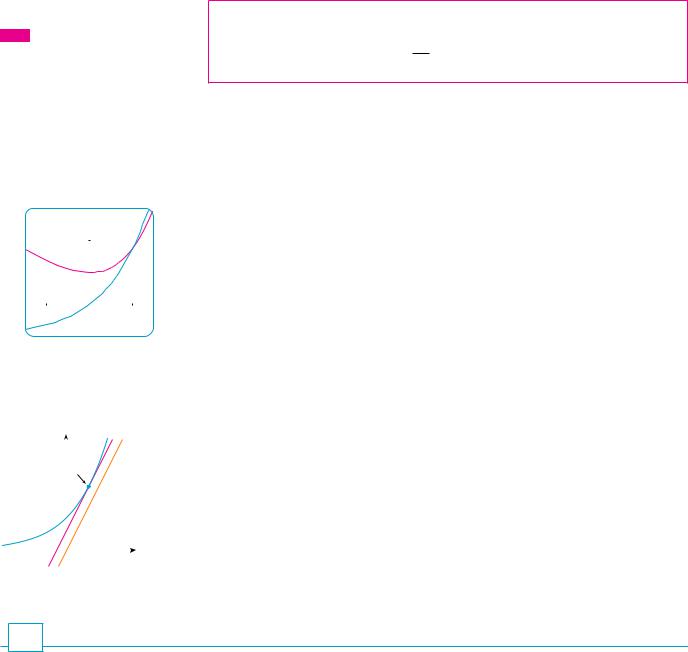
180 |||| CHAPTER 3 DIFFERENTIATION RULES
TEC Visual 3.1 uses the slope-a-scope to illustrate this formula.
DERIVATIVE OF THE NATURAL EXPONENTIAL FUNCTION
dxd !ex " ! ex
Thus the exponential function f ! x" ! ex has the property that it is its own derivative. The geometrical significance of this fact is that the slope of a tangent line to the curve y ! ex is equal to the y-coordinate of the point (see Figure 7).
|
|
|
|
|
|
|
|
|
|
|
|
|
|
|
|
|
EXAMPLE 8 If f ! x" ! ex " x, find f # and f (. Compare the graphs of f |
and f #. |
||||||||||||
|
|
|
|
|
|
|
|
|
|
|
|
|
|
|
|
V |
||||||||||||||
3 |
|
|
|
|
|
SOLUTION Using the Difference Rule, we have |
|
|
|
|
|
|
|
|||||||||||||||||
|
|
|
|
|
|
|
|
|
|
|
|
|
|
|
|
|
f #! x" ! |
d |
!ex " x" ! |
d |
!ex " " |
d |
!x" ! ex " 1 |
|
||||||
|
|
|
f |
|
|
|
|
|
|
|
dx |
dx |
dx |
|
||||||||||||||||
|
|
|
|
|
|
|
|
|
|
|
|
|
f» |
|
|
In Section 2.8 we defined the second derivative as the derivative of f #, so |
|
|||||||||||||
|
|
|
|
|
|
|
|
|
|
|
|
|
|
|
|
|||||||||||||||
_1.5 |
|
|
|
|
|
|
|
|
|
|
|
|
|
|
1.5 |
|
f (!x" ! |
|
d |
!ex " 1" ! |
|
d |
!ex " " |
|
d |
!1" ! ex |
|
|||
|
|
|
|
|
|
|
|
|
|
|
|
|
|
|
|
|
|
|
||||||||||||
|
|
|
|
|
|
|
|
|
|
|
|
|
|
|
|
|
|
|
|
|
||||||||||
|
|
|
|
|
|
|
|
|
|
|
|
|
|
|
|
|
|
|
|
|
|
|||||||||
_1 |
|
|
|
|
|
|
|
|
|
dx |
dx |
dx |
|
|||||||||||||||||
|
|
|
|
|
|
|
|
|
|
|
|
|
|
|
|
|
|
|
|
|||||||||||
FIGURE 8 |
|
|
|
|
|
The function f and its derivative f # are graphed in Figure 8. Notice that f |
has a horizon- |
|||||||||||||||||||||||
|
|
|
|
|
|
|
|
|
|
|
|
|
|
|
|
tal tangent when x ! 0; this corresponds to the fact that f #!0" ! 0. Notice also that, |
||||||||||||||
|
|
|
|
|
|
|
|
|
|
|
|
|
|
|
|
for x ' 0, f #!x" is positive and f is increasing. When x & 0, f #! x" is negative and f is |
||||||||||||||
|
|
|
|
|
|
|
|
|
|
|
|
|
|
|
|
decreasing. |
|
|
|
|
|
|
|
|
|
|
M |
|||
|
|
|
y |
|
|
|
|
|
|
|
EXAMPLE 9 At what point on the curve y ! ex is the tangent line parallel to the |
|||||||||||||||||||
|
|
|
|
|
|
|
||||||||||||||||||||||||
3 |
|
|
|
|
|
|
|
|
|
|
|
|
||||||||||||||||||
|
|
|
|
|
|
|
|
|
|
|
|
|||||||||||||||||||
|
|
|
( |
|
|
|
|
|
|
|
|
line y ! 2x? |
|
|
|
|
|
|
|
|
|
|
|
|||||||
|
|
|
ln#2,#2) |
|
|
|
|
|
|
|
|
|
|
|
|
|
|
|
|
|||||||||||
2 |
|
|
|
|
|
|
|
y=2x |
|
|
SOLUTION Since y ! ex, we have y# ! ex. Let the x-coordinate of the point in question be |
|||||||||||||||||||
|
|
|
|
|
|
|
|
|
||||||||||||||||||||||
1 |
|
|
|
|
|
|
|
|
|
a. Then the slope of the tangent line at that point is ea. This tangent line will be parallel |
||||||||||||||||||||
|
|
|
|
|
|
|
|
|
|
|
|
to the line y ! 2x if it has the same slope, that is, 2. Equating slopes, we get |
||||||||||||||||||
|
|
|
|
|
|
|
|
|
|
|
|
|||||||||||||||||||
y=« |
|
|
|
|
|
|
|
|
|
|
|
|
|
|
|
|
|
|
|
|
|
|
||||||||
|
|
|
|
|
|
|
|
|
|
x |
|
|
|
|
|
|
ea ! 2 |
a ! ln 2 |
|
|
|
|||||||||
|
|
|
|
|
0 |
|
|
|
1 |
|
|
|
|
|
|
|
|
|
||||||||||||
FIGURE 9 |
|
|
|
|
|
Therefore the required point is !a, ea " ! !ln 2, 2". (See Figure 9.) |
M |
|||||||||||||||||||||||
3.1E X E R C I S E S
1.(a) How is the number e defined?
(b) Use a calculator to estimate the values of the limits
lim |
2.7h " 1 |
and |
lim |
2.8h " 1 |
|
h |
h |
||||
h l0 |
|
h l0 |
correct to two decimal places. What can you conclude about the value of e?
2.(a) Sketch, by hand, the graph of the function f ! x" ! ex, paying particular attention to how the graph crosses the y-axis. What fact allows you to do this?
(b)What types of functions are f ! x" ! ex and t! x" ! xe ? Compare the differentiation formulas for f and t.
(c)Which of the two functions in part (b) grows more rapidly when x is large?
3–32 Differentiate the function. |
|
|
|
|
|
3. |
f ! x" ! 186.5 |
4. |
f ! x" ! s |
|
|
30 |
|||||
5. |
f ! t" ! 2 " 32 t |
6. |
F! x" ! 43 x8 |
||
7. |
f ! x" ! x3 " 4x ! 6 |
8. |
f !t" ! 21 t6 " 3t4 ! t |
||

SECTION 3.1 DERIVATIVES OF POLYNOMIALS AND EXPONENTIAL FUNCTIONS |||| 181
9. |
f !t" ! 41 !t4 ! 8" |
||||
11. |
y ! x"2%5 |
||||
13. |
V!r" ! 34 )r3 |
||||
|
12 |
|
|||
15. |
A!s" ! " |
|
|
||
s5 |
|||||
17. |
G! x" ! s |
|
" 2ex |
||
x |
|||||
19. |
F ! x" ! (21 x)5 |
||||
21.y ! ax2 ! bx ! c
23.y ! x2 ! 4x ! 3 sx
25.y ! 4)2
27. H! x" ! ! x ! x"1"3
29. u ! s5 t ! 4st5
31. z ! yA10 ! Bey
10. h! x" ! ! x " 2"!2x ! 3"
12. y ! 5ex ! 3
14. R!t" ! 5t"3%5
16. B! y" ! cy"6
18. y ! s3 x
1
20. f !t" ! st " st
22. y ! sx ! x " 1"
24. y ! x2 " 2sx x
26. t!u" ! s2 u ! s3u
28. y ! aev ! bv ! vc2
30. v ! &sx ! s31x '2
32. y ! ex!1 ! 1
33–34 Find an equation of the tangent line to the curve at the given point.
4 |
|
|
!1, 1" |
34. y ! x |
4 |
! 2x |
2 |
" x, |
!1, 2" |
33. y ! sx , |
|
|
|||||||
35–36 Find equations of the tangent line and normal line to the curve at the given point.
35. y ! x4 ! 2ex , !0, 2" |
36. y ! !1 ! 2x"2, !1, 9" |
|
|
;37–38 Find an equation of the tangent line to the curve at the given point. Illustrate by graphing the curve and the tangent line on the same screen.
37. y ! 3x2 " x3, !1, 2" 38. y ! x " sx , !1, 0"
; 39– 42 Find f #! x". Compare the graphs of f and f # and use them
to explain why your answer is reasonable. |
|
|
||||
39. |
f ! x" ! ex " 5x |
40. |
f ! x" ! 3x5 " 20x3 ! 50x |
|||
41. |
f ! x" ! 3x15 " 5x3 ! 3 |
42. |
f ! x" ! x ! |
1 |
|
|
x |
||||||
|
|
|
|
|||
|
|
|
|
|
|
|
;43. (a) Use a graphing calculator or computer to graph the function f ! x" ! x4 " 3x3 " 6x2 ! 7x ! 30 in the viewing rectangle ("3, 5) by ("10, 50).
(b)Using the graph in part (a) to estimate slopes, make a rough sketch, by hand, of the graph of f #. (See Example 1 in Section 2.8.)
(c)Calculate f #! x" and use this expression, with a graphing device, to graph f #. Compare with your sketch in part (b).
;44. (a) Use a graphing calculator or computer to graph the function t! x" ! ex " 3x2 in the viewing rectangle ("1, 4) by ("8, 8).
(b)Using the graph in part (a) to estimate slopes, make a rough sketch, by hand, of the graph of t#. (See Example 1 in Section 2.8.)
(c)Calculate t#! x" and use this expression, with a graphing device, to graph t#. Compare with your sketch in part (b).
45– 46 Find the first and second derivatives of the function.
45. f ! x" ! x |
4 |
" 3x |
3 |
! 16x |
46. |
|
|
3 |
|
|
|
|
G! r" ! sr ! sr |
||||||||
;47– 48 Find the first and second derivatives of the function. Check to see that your answers are reasonable by comparing the graphs of f , f #, and f (.
47. |
f ! x" ! 2x " 5x3%4 |
48. f ! x" ! ex " x3 |
|
|
|
|
|
|
|
The equation of motion of a particle is s ! t3 " 3t, where s |
|
49. |
|||
|
|
is in meters and t is in seconds. Find |
|
(a)the velocity and acceleration as functions of t,
(b)the acceleration after 2 s, and
(c)the acceleration when the velocity is 0.
50.The equation of motion of a particle is
s ! 2t3 " 7t2 ! 4t ! 1, where s is in meters and t is in seconds.
(a)Find the velocity and acceleration as functions of t.
(b)Find the acceleration after 1 s.
;(c) Graph the position, velocity, and acceleration functions on the same screen.
51.Find the points on the curve y ! 2x3 ! 3x2 " 12x ! 1 where the tangent is horizontal.
52.For what values of x does the graph of
f ! x" ! x3 ! 3x2 ! x ! 3 have a horizontal tangent?
53.Show that the curve y ! 6x3 ! 5x " 3 has no tangent line with slope 4.
54.Find an equation of the tangent line to the curve y ! xsx that is parallel to the line y ! 1 ! 3x.
55.Find equations of both lines that are tangent to the curve
y ! 1 ! x3 and are parallel to the line 12x " y ! 1.
;56. At what point on the curve y ! 1 ! 2e x " 3x is the tangent line parallel to the line 3x " y ! 5? Illustrate by graphing the curve and both lines.
57.Find an equation of the normal line to the parabola
y ! x2 " 5x ! 4 that is parallel to the line x " 3y ! 5.

182|||| CHAPTER 3 DIFFERENTIATION RULES
58.Where does the normal line to the parabola y ! x ! x2 at the point (1, 0) intersect the parabola a second time? Illustrate with a sketch.
59.Draw a diagram to show that there are two tangent lines to the parabola y ! x2 that pass through the point !0, !4". Find the coordinates of the points where these tangent lines intersect the parabola.
60.(a) Find equations of both lines through the point !2, !3" that are tangent to the parabola y ! x2 " x.
(b)Show that there is no line through the point !2, 7" that is tangent to the parabola. Then draw a diagram to see why.
61.Use the definition of a derivative to show that if f ! x" ! 1%x, then f %! x" ! !1%x2. (This proves the Power Rule for the case n ! !1.)
62.Find the nth derivative of each function by calculating the first few derivatives and observing the pattern that occurs.
(a) f ! x" ! xn (b) f ! x" ! 1%x
63. Find a second-degree polynomial P such that P!2" ! 5, P%!2" ! 3, and P'!2" ! 2.
64. The equation y' " y% ! 2y ! x2 is called a differential equation because it involves an unknown function y and its derivatives y% and y'. Find constants A, B, and C such that the function y ! Ax2 " Bx " C satisfies this equation. (Differential equations will be studied in detail in Chapter 9.)
65. Find a cubic function y ! ax3 " bx2 " cx " d whose graph has horizontal tangents at the points !!2, 6" and !2, 0".
66. Find a parabola with equation y ! ax2 " bx " c that has slope 4 at x ! 1, slope !8 at x ! !1, and passes through the point !2, 15".
67. |
Let |
|
|
|
|
|
|
2 ! x |
if x # 1 |
|
|
f ! x" ! #x2 ! 2x " 2 if x $ 1 |
||
|
Is f differentiable at 1? Sketch the graphs of f and f %. |
|||
68. |
At what numbers is the following function t differentiable? |
|||
|
|
!1 ! 2x |
if x & !1 |
|
|
t! x" ! |
x2 |
if !1 # x # 1 |
|
|
|
#x |
if x $ 1 |
|
Give a formula for t% and sketch the graphs of t and t%.
69. (a) For what values of x is the function f ! x" ! $ x2 ! 9 $ differentiable? Find a formula for f %.
(b) Sketch the graphs of f and f %.
70. Where is the function h! x" ! $ x ! 1 $ " $ x " 2 $ differentiable? Give a formula for h% and sketch the graphs of h and h%.
71. Find the parabola with equation y ! ax2 " bx whose tangent line at (1, 1) has equation y ! 3x ! 2.
72. Suppose the curve y ! x4 " ax3 " bx2 " cx " d has a tangent line when x ! 0 with equation y ! 2x " 1 and a tangent line when x ! 1 with equation y ! 2 ! 3x. Find the values of a, b, c, and d.
73. For what values of a and b is the line 2x " y ! b tangent to |
||
|
the parabola y ! ax2 when x ! 2? |
|
74. |
Find the value of c such that the line y ! 23 x " 6 is tangent to |
|
|
the curve y ! csx . |
|
75. |
Let |
|
|
x2 |
if x # 2 |
|
f ! x" ! #mx " b if x $ 2 |
|
Find the values of m and b that make f differentiable everywhere.
76.A tangent line is drawn to the hyperbola xy ! c at a point P.
(a)Show that the midpoint of the line segment cut from this tangent line by the coordinate axes is P.
(b)Show that the triangle formed by the tangent line and the coordinate axes always has the same area, no matter where P is located on the hyperbola.
77. |
Evaluate lim |
x1000 ! 1 |
. |
|
x ! 1 |
||||
|
x l1 |
|
78.Draw a diagram showing two perpendicular lines that intersect on the y-axis and are both tangent to the parabola y ! x2. Where do these lines intersect?
79.If c $ 12 , how many lines through the point !0, c" are normal lines to the parabola y ! x2 ? What if c # 12 ?
80.Sketch the parabolas y ! x2 and y ! x2 ! 2x " 2. Do you think there is a line that is tangent to both curves? If so, find its equation. If not, why not?
|
A P P L I E D |
BUILDING A BETTER ROLLER COASTER |
|
P R O J E C T |
|
|
Suppose you are asked to design the first ascent and drop for a new roller coaster. By studying |
|
|
|
|
|
|
|
|
|
photographs of your favorite coasters, you decide to make the slope of the ascent 0.8 and the |
|
|
slope of the drop !1.6. You decide to connect these two straight stretches y ! L1! x" and |
|
|
y ! L2! x" with part of a parabola y ! f ! x" ! ax2 " bx " c, where x and f ! x" are measured in |
|
|
feet. For the track to be smooth there can’t be abrupt changes in direction, so you want the linear |
|
|
|
